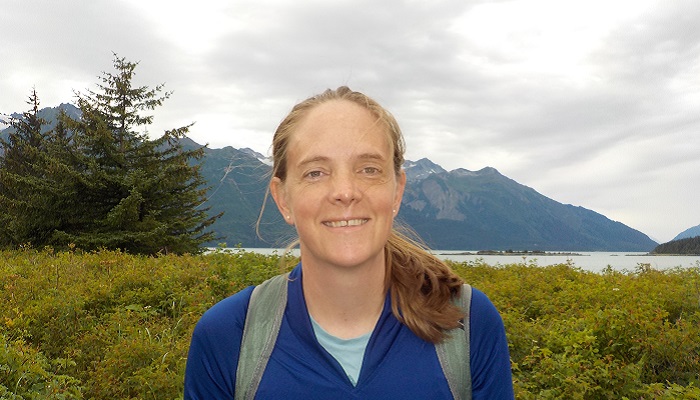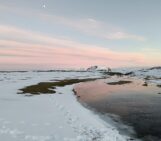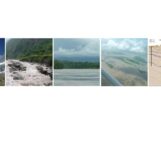
Kristen Cook, Research Officer for the Institut de Recherche pour le Développement (IRD), based at ISTerre, University of Grenoble, is the new elected president of the EGU’s Geomorphology Division. As she prepares to assume her new role during the 2023 General Assembly, the outgoing Early Career Scientist (ECS) representative, Aayush Srivastava, postdoctoral researcher at the University of St. Andrews, seized the opportunity to conduct an interview with her, discussing her upcoming tenure, aspirations, and plans.
Aayush: How do you describe your field of interest to fellow EGU members and the wider community?
Kristen: I always find it tough to define my field because I’m interested in so many different things! In the past years I have been focusing on erosion and sediment transport processes in steep landscapes and bedrock rivers, and particularly the dynamics and impacts of extreme events. On the technique side, I am interested in environmental seismology and UAV and TLS-derived high-resolution topography. I have also done work on longer-term landscape evolution and tectonic geomorphology, and my PhD was in tectonics and geodynamics.
What inspires you to become the president of GM Division?
The journey towards becoming GM Division president began when I decided, as an early career scientist (ECS), to start getting involved by convening a session. I followed this with more session convening and gradually built up my involvement, volunteering to become a division science officer, organizing a Galileo conference, helping with an AOGS-EGU joint conference series, volunteering to be the OSPP coordinator. I found these really rewarding – I liked being able to contribute to the community, and it’s pretty satisfying to see how your efforts and ideas can actually make a difference. I also found that I did actually have some good ideas(!), and was increasingly wishing that I could be involved in the higher level planning and decision making. So running for division president was a natural next step. It also didn’t escape my attention that the GM division had never had a woman president, and that I could potentially change that.
However, while I knew that I was interested in being the division president, and I thought that I could do a good job, it was still a difficult decision. This was because at the time of the election, I (like many of us) did not have a permanent position and was nearing the end of my contract, with no idea what would come next. In the end, I decided that I wouldn’t let this uncertainty limit my choices (and that if I did end up unemployed, then at least I’d have plenty of time to spend on EGU). Luckily things worked out, and I am now (finally!) settled in a permanent position, but I am sharing this story because I think it’s important to have people in leadership roles who have experienced the precarity that so many ECS members (and beyond) are faced with these days.
What are key things you wish to change or work on after starting your term as the president?
Dan and our other past leadership have left the division in great shape, so I’m not looking to make massive changes! But areas that I aim to work on include the next two questions – diversity and inclusion and supporting and involving ECS members, so I’ll leave those for later.
In the short term, I think it’s important that we work to strengthen the GM community after the past years of disruption. This year is our first General Assembly (GA) in four years to have posters and picos, not to mention receptions and various other social/networking activities! For those of us who have been around a while, it’s easy to forget that many members have never experienced a “normal” EGU and may feel less integrated into the division. As a small example, I will push hard to get our GM ‘Meet the Expert’ session back for future years! Similarly, figuring out how to best maintain interaction and networking between in-person and virtual conference attendees is a key challenge for the coming years, both within the division and across the EGU.
Of course, we also need to keep our science at the forefront! The division is now well-established, and has made the GA a key meeting for geomorphologists. I will work to continue this and make sure that we build a high-quality and comprehensive GA programme each year. I will also aim to facilitate our science outside the GA, by supporting proposals for GM-involved Galileo conferences, training schools, and outreach events, and by supporting the Landscape Live series however I can. I am also very keen to continue GM’s strong interdisciplinary ties, as I think this is a key strength of our division.
What is your view on the role of ECS members within the division and any tips for them to be more involved?
ECS members are fundamental to the division! There are the stats that ECSs are more than 50% of EGU membership, but I think this really understates their importance. They not only contribute a ton of great science, they’re also key for the organization of the General Assembly – I actually just counted, and more than 50% of the GM session conveners for 2023 are ECSs. Not to mention the important work done by the GM ECS team both around the GA and throughout the year!
For ECS members who would like to be more involved, the most common way to start is to convene a session or short course for the General Assembly. Session organizing is open to everybody, and we are always happy to see new ideas and new conveners. If you’re not sure how to jump into convening, you can get in touch with me or a programme committee member. You could also get in touch with conveners of an existing session to see if you can join the team – this was how I got my convening start!
For those looking for more sustained involvement, ECSs are welcome in all of the division roles. Of course, there is the division ECS team – reach out to them if you are interested to contribute! ECS members also can found on the Science Officer and Landscapes Live teams – keep an eye on the GM mailing list for calls for new team members. ECS members are also encouraged to get involved with organizing one-off EGU-sponsored events such as Galileo Conferences.
Turning things around, it’s important to make sure that the division as a whole is meeting the needs of ECS members, around not just science, but also networking, exposure, and career and professional development. I am always open to feedback and suggestions about what we can be doing to support our ECS members.
How will you ensure diversity and inclusiveness within the EGU GM division?
This is a topic that is very important to me! Over the past years, we have made a lot of progress in terms of gender balance, for example in our award winners (at all levels – Bagnold, ECS, and OSPP), the composition of our committees, solicited speakers, etc. It’s important to build on this progress, but I think we have even more work to do in increasing diversity and inclusion across a range of axes. This is something that we can consider directly when it comes to recruiting for division positions, award nominations, and session conveners. Increasing the diversity of the division membership and, importantly, ensuring that everyone feels welcome and included is another challenge. Here I would like to highlight that the EGU does have a code of conduct, and any violations at the GA can be reported confidentially to the person of trust at conduct@egu.eu.
Another aim is to expand the reach of EGU Geomorphology, both within Europe and farther afield. One avenue for this is to strengthen ties with partners such as the IAG (International Association of Geomorphologists), and build connections with national geomorphology societies from countries that are currently underrepresented within the division. This could involve things like co-sponsored sessions, or co-sponsored events such as training schools, Galileo conferences, or outreach events, all of which EGU can provide support for.
The new hybrid format of the GA is also a great opportunity to broaden our reach. For example, with fee waivers for virtual participation, bachelors and masters students from anywhere in the world, and any colleagues based in lower-middle/low income countries can participate for free in the meeting and make connections with the community. I will work to widely advertise these opportunities and encourage participation, and advocate for continuing these fee waivers. As well as enabling full virtual attendance, the hybrid format provides more flexibility for participants who can’t attend in person for the entire week, or can’t spend full days at the conference center – people can adjust their participation to suit their needs without needing to miss out on large portions of the meeting. As we see other societies go back to in-person only meetings, I will strongly advocate for continuing a hybrid format, as an accessibility and inclusion issue (not to mention climate-friendly).
Finally, is there any interesting upcoming activity that you would like to let our readers know about?
Well, very shortly upcoming is the Steepest Descent meeting! This will take place on 23 April to kick off the EGU GA. From there, be sure to come over to the conference center for the opening reception which is back this year at 18:30 on Sunday. And of course there are loads of things happening during the week – look out for emails about highlights!
Landscapes Live will start up again on 4 May with an exciting lineup of weekly talks each Thursday at 16:00 CET (https://www.landscapeslive.org/)! I highly recommend participating – it’s a great chance to attend in-depth talks and discussion with a range of geomorphologists from around the world. There is also the IAG regional conference in Cappadocia, Türkiye in September (https://rcg2023.info/). Along with the science, Cappadocia is an amazing place with really fascinating geomorphology. Watch out for division emails and keep an eye on our social media feeds for more upcoming activities!



